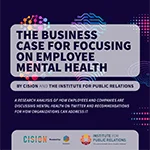 |
The mushrooming rate of employee burnout and rise of “quiet quitting” are big issues for both employers and workers in today’s job environment—and Twitter is turning out to be a major stage on which the controversies around those topics are playing out.
That’s the conclusion of a study from the Institute for Public Relations and Cision, which looked at over 1.3 million Twitter posts that went online between Jan. 1 and Oct. 31 of 2022.
Those posts give a detailed look at the changing set of priorities being voiced by many employees and show some ways in which companies can successfully respond to them.
One prominent trend was a shift in how many workers measure professional success. “I actually don’t want to climb any corporate ladders,” one poster said, “I just want to have income to fund my lifestyle, help other people, and be around good humans.”
 |
That sentiment goes hand in hand with a general focus on quality of life—and the pursuit of a better quality of life emphasizes time as much as it does money. For example, a four-day work week was a big draw for many workers. However, the study authors say that “it is important to note that shifting from five eight-hour days to four 10-hour days is not the key to alleviating employee burnout.”
But a substantive shift to a shorter week is seen as paying big dividends. A tweet from MarketWatch noted that 63 percent of companies who put a four-day work schedule into place found it easier to attract and retain talent, while 78 percent of employees working a four-day week said they were happier and less stressed out.
There was also a strong desire for companies who claim that they support the mental health of their employees to back up those claims with action. “Organizations that showcased their mental health program but were accused of not doing so in practice were attacked,” the report says.
The report gives companies several pointers for how they can address mental health in the workplace, with the potential result of alleviating burnout and reducing the incidence of “quiet quitting” (and the old-fashioned kind of quitting as well).
Providing benefits such as “mental health days” is one strategy the study suggests. Training for company leaders around mental health issues is another, as is investing financially in employee wellness and providing such opportunities for social support as employee resource groups.
Finally, the study says that employers simply need to “listen to their employees and better understand their needs.”
The IPR/Cision study was conducted using Brandwatch’s Consumer Research tool.


 Employees at U.S. companies are experiencing high levels of burnout, but managers are lagging behind when it comes to their awareness of the problem
Employees at U.S. companies are experiencing high levels of burnout, but managers are lagging behind when it comes to their awareness of the problem Brand has a powerful effect on a company’s valuation, but the level of brand understanding in the investment community leaves a lot to be desired, according to a new study from Brodeur Partners, Interbrand and NewtonX.
Brand has a powerful effect on a company’s valuation, but the level of brand understanding in the investment community leaves a lot to be desired, according to a new study from Brodeur Partners, Interbrand and NewtonX. AI may still be viewed with a wary eye by most media pros, but its use is growing, according to a new study from Muck Rack.
AI may still be viewed with a wary eye by most media pros, but its use is growing, according to a new study from Muck Rack. A new study from Walker Sands says that some marketers have been putting the cart before the horse when it comes to the relationship between marketing channels and business outcomes.
A new study from Walker Sands says that some marketers have been putting the cart before the horse when it comes to the relationship between marketing channels and business outcomes. Thought leadership can make made B2B brands more "powerful and attractive to buyers," according to Edelman report.
Thought leadership can make made B2B brands more "powerful and attractive to buyers," according to Edelman report.


 Have a comment? Send it to
Have a comment? Send it to 
No comments have been submitted for this story yet.